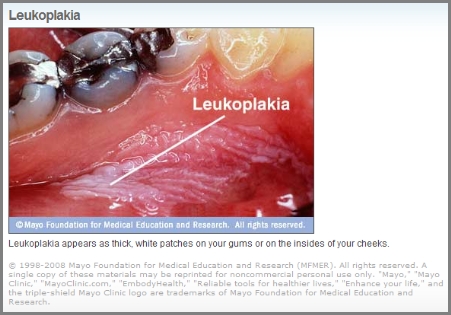smokeless tobacco or snuff - is it safe? |
||||||||||||||||||||
Myth #1: Smokeless tobacco is safe, not like smoking cigarettes?
Your risk is not limited to mouth or oral cancer. Other cancers which are possibly linked with smokeless tobacco use include cancer of the esophagus, pharynx, larynx, sinuses or nasal passages and even the pancreas. As a smokeless tobacco user, your chance of getting any type of oral cancer is 50 times greater than a nonuser. Approximately half of those diagnosed with oral cancer die within 5 years.
What about my teeth?Dental problems are another risk of smokeless tobacco use. Wasting away or receding of your gum line, redness and swelling of your gum can be seen at the spot where your chew is placed. As your gums recede, roots of the tooth are exposed. The roots are then susceptible to bacteria, infections and ultimately loss of teeth. Tobacco also stains your teeth! How else does smokeless tobacco affect me?The blood levels of nicotine found in smokeless tobacco users are similar to those found in cigarette smokers. This means that the health risks associated with nicotine exposure may be the same for cigarette and smokeless tobacco users. Nicotine is a stimulant. It will increase your blood pressure and pulse which puts stress on your heart and blood vessels. This stress increases your risk of high blood pressure, stroke and heart attack. Nicotine also plays a role in causing stomach ulcers. Ulcers have a very difficult time healing if they are continually exposed to nicotine. What is in smokeless tobacco?Smokeless tobacco is available in two forms. Snuff is a finely ground tobacco which is either dry (inhaled or sometimes placed in the mouth)or moist (placed in the mouth). Chewing tobacco comes in three forms: loose, leaf, plug or twist. All forms of chewing tobacco are held or chewed in the mouth. There are 2,550 known compounds in processed tobacco in addition to nicotine. Smokeless tobacco contains at least 30 metals including nickel and a radioactive compound called polonium-210. Formaldehyde and nitrosamines are also found in smokeless tobacco. All of these compounds have been known to cause cancer. Nitrosamines are the most cancer-causing agents that form in tobacco during its processing. Small amounts are found in many other products such as beer, bacon and other foods. Nitrosamine concentrations in snuff are over 100 to 1,000 times greater than the regulated levels found in these other products. Snuff and chewing tobacco contain high concentrations of sodium (salt). If you swallow tobacco juice, the sodium may contribute to the risk of high blood pressure. High blood pressure has been found to be a problem for a number of smokeless tobacco users. Several kinds of sugar are found in unprocessed chewing tobacco and added during its processing. The consistent exposure to these sugars while having a chew in your mouth may cause dental cavities. Myth #2: Smokeless tobacco is not as addicting as cigarettes.Smokeless tobacco users do become addicted to the nicotine in the tobacco. Smokeless tobacco use leads to a constant level of nicotine throughout the day at a level similar to a cigarette smoker. Your body becomes used to this level of nicotine and when you try to quit or cut down, you experience withdrawal symptoms. These symptoms may include irritability, impatience, anxiety, tension, poor concentration, sleep problems, changes in appetite, and craving. Some smokeless users who have kicked cigarettes have said quitting snuff or chew can be as tough or tougher. Myth #3: Smokeless tobacco improves my physical performance in my sport.Studies have shown that athletes who use smokeless tobacco do not function any better than non-users. There is no increase in reaction time or endurance in athletic activities. Using snuff or chewing tobacco can even have a detrimental effect on your performance since nicotine will increase your blood pressure and heart rate. This increase may give you a feeling of preparedness. However, the elevated blood pressure and heart rate actually decreases your heartís performance and thereby reduces your overall stamina. How do Cigarettes and Smokeless Tobacco Compare?
This page was based on the information on the following sites: |
 Many
people believe that using smokeless tobacco is safe. However, smokeless
tobacco can cause cancer! Cancer risks are especially high where the
smokeless tobacco is in direct contact with the cheek and gum. Lesions
or sores can be found as the site where tobacco is placed. These
lesions are seen in almost 50% of all snuff users. Leukoplakia is the
medical term for the white patches you may see on your tongue or cheek.
The patches can occasionally crack and become ulcer-like, and may become
malignant or cancerous.
Many
people believe that using smokeless tobacco is safe. However, smokeless
tobacco can cause cancer! Cancer risks are especially high where the
smokeless tobacco is in direct contact with the cheek and gum. Lesions
or sores can be found as the site where tobacco is placed. These
lesions are seen in almost 50% of all snuff users. Leukoplakia is the
medical term for the white patches you may see on your tongue or cheek.
The patches can occasionally crack and become ulcer-like, and may become
malignant or cancerous.